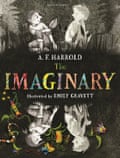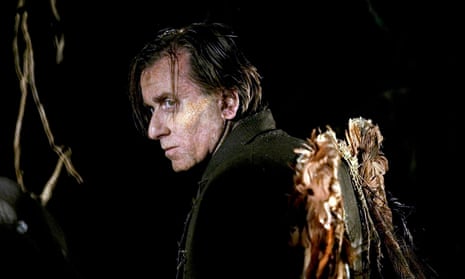All characters in fiction are imaginary friends. We spend time with them, listen to them, laugh with them, sometimes fall in love with them. No one else knows them like we do. It can be embarrassing to talk to them when other people are in the room.
But they’re not what this list is about.This list is about imaginary friends characters in books have had, so the imaginary friends of my imaginary friends, you might say.
It runs the gamut, from characters who are clearly imaginary to some who are much more ambiguous, to some for whom it really depends which way the wind’s blowing when you think about them. Some aren’t as nice as others, but all are memorable in their own ways.
Not all of my choices are from the world of children’s books, because not all imaginary friends live there and because that’s not all I read, but I don’t think there’s anything here that it unsuitable for children to read or watch (there are two plays which are both very funny and often staged). Number 7 is possibly the “hardest” book on the list, but any teenagers with an inquiring, philosophical bent to their minds will love it.
By the way, to prepare this list I asked my imaginary/semi-real/unseen friends on Facebook for suggestions and received such a rush of replies of characters from books I’ve not read and from films I’ve not seen that I had to ignore them almost totally. I can therefore guarantee this list will seem inadequate, wrongheaded and disappointing to many people. But never mind, at no point does it claim to be exhaustive or exclusive. Feel free to add to it.
And to save arguments, they are in alphabetical order.
1. – Bear, from Raymond Briggs’ The Bear
Possibly my favourite Raymond Briggs book, along with most of the others, this one tells the story of a girl who wakes up one morning to find a polar bear has climbed into her bedroom. It’s big, it smells, it has claws. They spend the day together. Have domestic adventures. Make messes. And then, at the end, the Bear goes away, swimming back to the North.
2. Bunbury, from Oscar Wilde’s The Importance of Being Earnest
Imaginary friends are there to take the heat for us. They can be blamed for the accidents we have. ‘I didn’t break the vase, Mum, it was Rudger,’ for example. Algernon Moncrieff’s non-existent invalid friend Bunbury serves the same function, allowing him to get out of dull social affairs. Invalid friends in the country do this. We should all have one.
3. Elvira, from Noël Coward’s Blithe Spirit
Some imaginary friends are good for you, some aren’t. When your dead wife comes home after Madame Arcati’s farcical séance and begins to comment, you know exactly where you are. Coward wrote this play whilst at Portmeirion in Wales, a place perfectly fitted to imaginariness.
4. Hobbes, from Bill Watterson’s Calvin and Hobbes
To me, the most important imaginary friend, the most moving, the most delightful, the most grrr-ry, the most graceful, the wisest, most forebearing, most put upon, the funniest and handsomest (certainly the best drawn) is Hobbes. He’s a tiger and he’s perfect.
5. The Imaginary Friend, from Matt Harvey’s The Hole In The Sum Of My Parts
Matt Harvey is one of the loveliest poets I know, briefly famous for being Wimbledon’s first poet-in-residence and for hosting BBC Radio 4’s Wondermentalist Cabaret. In his prose poem Imaginary Friend he tells the tragic story of how being a shy and withdrawn child he had an imaginary friend, who was also shy and withdrawn and had his own imaginary friend. “[T]he two of them used to play together and exclude me,” he says. As with all of Harvey’s work, it is a lightfooted, calm-mouthed, moving piece of deceptively funny writing. Go read it.
6 . Malcolm/Sally, a stuffed stoat, from Philip Ardagh’s Eddie Dickens’ Trilogy
Possibly a contentious choice, but Even Madder Aunt Maud sincerely believes in the veracity and vivacity of her companion. She frets, she worries, she loves that stuffed mustalid like one of the family, while everyone else knows it’s just a mangy old no-longer-vital stoat. But then again, to Calvin’s parents’ eyes Hobbes is just a cuddly stuffed tiger.
7. The Policemen, from Flann O’Brien’s The Third Policeman
Another choice some people won’t agree with, but I let the post-death Elvira in, why be afraid to take the same step in the opposite direction? It’s a puzzle this book, and it would be a shame to attempt to unpick it for anyone who’s not yet had the joy of swimming in its paradoxical, philosophical, intoxicating waters. It’s sometimes been called a grown-up Alice In Wonderland and that seems close enough. It’s a great treat for the enquiring teenager (or any) mind, especially an enquiring mind not in search of anything specific. It’s a book that should be read twice, at least. And you’ll never look at a bicycle the same again.
8. Skellig, from David Almond’s Skellig
You can read Skellig, of course, in a variety of ways. Maybe it’s all real. Maybe it’s real, but supernatural. Maybe it’s real, but Blakean. Certainly William Blake’s angels and cherry blossom spin in the shadow of the withered old man Michael finds in his garage. He shares the magic with Mina, and the pair of them share in the transfigurative, soul-lifting power of Skellig. Maybe it’s all real. Maybe it’s not. Maybe it doesn’t matter. He’s on the list anyway.
9. The Story Giant, from Brian Patten’s The Story Giant
In this book four children share a dream. They all wake in the Castle of the Story Giant, a being that only comes alive when children dream him. He collects all the stories of the world, from the very dawn of consciousness and is waiting to hear the one last story he’s not yet found before he dies. This is a very wonderful collection of folk tales and version, told in Patten’s pinpoint prose.
10. The Wild Things, from Maurice Sendak’s Where The Wild Things Are
This is the beginning for me. The first book that showed me the trip into imagination. Images from it made their way into The Imaginary, both in my words and in, at least one of, Emily Gravett’s illustrations. This book is perfect. I longed for a wolf suit. I longed for supper to still be hot when I got home. Nothing else needs be said.
- AF Harrold and Emily Gravett’s The Imaginary is available in the Guardian bookshop.

